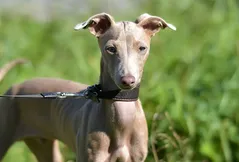
Peruvian Inca Orchid
Agile, smart and swift, the Peruvian Inca Orchid is an elegant sighthound. They are also affectionate, loyal and noble.
Overall Status
| Height | 17 to 22 inches at the shoulder |
| Temperament | Affectionate, Loyal, Noble |
| Weight | 8.5 to 55 pounds |
| Life Expectancy | 11 to 12 years |
| Coat Color | Black, Brown, Gray, White |
| Barking Level | When Necessery |
Quick Factors
| Playfulness | |
| Dog Friendly | |
| Exercise Need | |
| Grooming Needs | |
| Strangers Friendly | |
| Family Affectionate |
Daily Care
Grooming Tips
Hairless Peruvian Inca Orchids obviously don’t need to have their coats groomed, because they have no coats. However, they still need grooming. They should not go outdoors without sunscreen or a wrap of some sort, to provide protection from the sun or from chilly weather.Their skin should be wiped down with a warm, damp cloth every few days to remove dirt, dust and debris. Their skin also should be moisturized regularly with lotion or oil appropriate for use on dogs. The coated variety rarely sheds.However, its coat is prone to developing tangles and should be brushed regularly to keep it neat and tangle-free. Regular baths, with a very gentle shampoo, are important in both varieties of this breed. Ears, nails and teeth should be cared for as in any breed, with regular cleaning, clipping and brushing, respectively.
Exercise Tips
Like any hunting breed, Peruvian Inca Orchids require a great deal of rigorous exercise. They can often run at extremely high speeds for long distances.Options for exercise include playtime in the backyard, preferably fenced, or going on walks several times a day. Exercise can also come in the form of indoor activities, like hide-and-seek, chasing a ball rolled along the floor, or learning new tricks.If you live in an apartment, even short walks in the hallways can give your dog some exercise, especially during inclement weather. Training for dog sports like agility, obedience, and rally can also be a great way to give your dog exercise.Responsible owners should make sure that their dogs get enough physical activity each day to drain their energy levels. A failure to do so can often result in an unhappy and sometimes destructive dog.
Feeding Tips
Peruvian Inca Orchids are a high-energy breed and should be fed on two to three daily meals of high-quality dog food.Any diet should be appropriate to the dog’s age (puppy, adult, or senior).Some dogs are prone to gettingoverweight, so watch your dog’s calorie consumption and weight level.Treatscan be an important aid in training, but giving too many can cause obesity.Learn about whichhuman foodsare safe for dogs, and which are not. Check with your vet if you have any concerns about your dog’s weight or diet.Clean, fresh water should be available at all times.
Health Tips
The average life expectancy of the Peruvian Inca Orchid is between 11 and 13 years. While the breed is generally regarded as being healthy, its limited genetic diversity and hairlessness contribute to several health concerns. The genes responsible for hairlessness also affect dentition.Hairless PIOs usually are missing some of their teeth and are prone to other dental problems. Most of them are born without premolars, and some without molars, which can make it difficult for them to chew hard food. Some also are missing one or both of their canine teeth. The coated variety should have full dentition.Other breed health concerns include inflammatory bowel disease (IBD), dry skin, strokes and seizures. PIOs are especially sensitive to cold and to sunlight. The hairless variety is particularly predisposed to acne and sunburn and suffers disproportionately from physical contact with pesticides or other harmful toxins that are easily absorbed through bare skin.
Trainability
Peruvian Inca Orchids require a great deal of socialization and should be kept in the house, as they do not make good outdoor dogs.This breed is intelligent and can be a challenge to train. New owners should be able to commit to a substantial amount of time needed to train and socialize their new PIO puppy. Because they are a primitive breed, they have a wide range of temperaments, from a typical docile sighthound to a more feral temperament.PIOs are not recommended for families with small children, but they can do well with older, more considerate kids. Rough play is discouraged with puppies, as this can promote aggressive behavior. They can be raised with smaller dogs or cats, but require supervision.
History
When Spanish conquistadors invaded Peru, one of the amazing discoveries they made was the presence of hairless dogs in Incan homes, lounging in orchid-scented luxury. They called the dogs “perros flora,” or flower dogs and reported that the hairless dogs were highly valued and allowed out only at night so they wouldn’t become sunburned.They were sequestered as well from the coated dogs, which were kept indoors at night so the hairless dogs could have the moonlit nights to themselves. The resulting small gene pool probably contributed to the missing teeth, linked to the hairless gene, that is often seen in the hairless variety.The interesting hairless dogs from Peru were first brought to the United States in 1966. The United Kennel Club recognized the breed in 1996, and it is part of the American Kennel Club’s Miscellaneous Class, the last stop before full recognition. The Peruvian government declared the breed a national patrimony in 2001.






